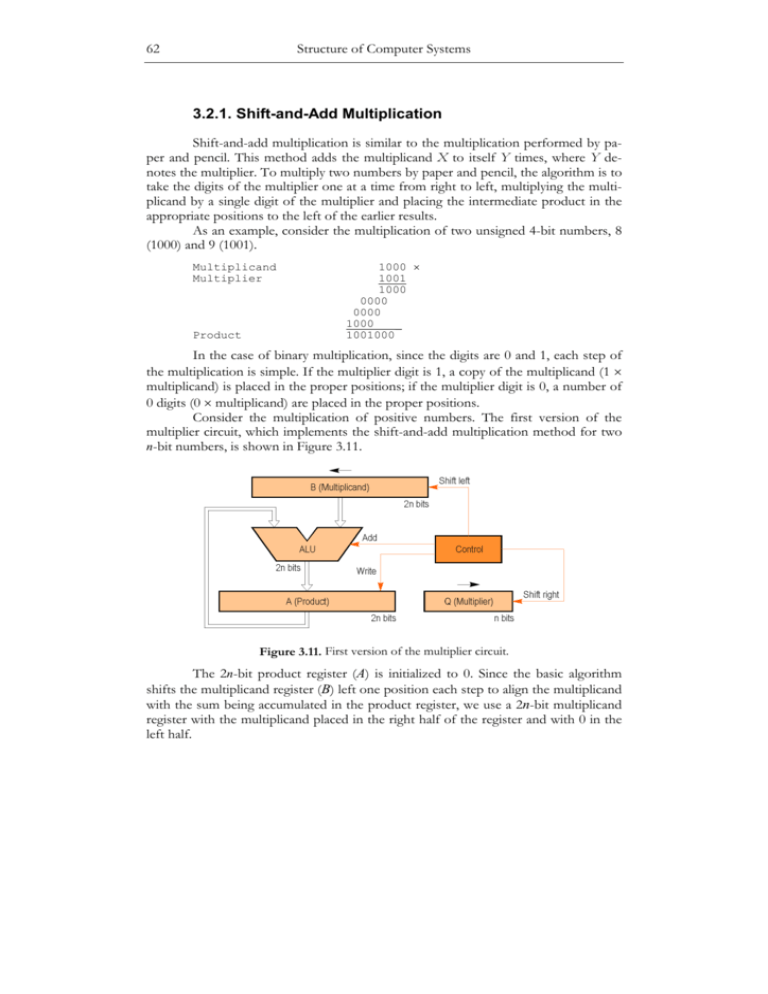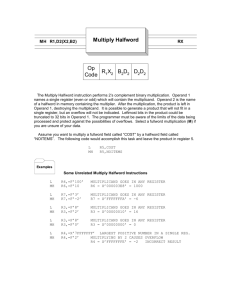Shift-and-Add Multiplication in Computer Systems
advertisement

62 Structure of Computer Systems 3.2.1. Shift-and-Add Multiplication Shift-and-add multiplication is similar to the multiplication performed by paper and pencil. This method adds the multiplicand X to itself Y times, where Y denotes the multiplier. To multiply two numbers by paper and pencil, the algorithm is to take the digits of the multiplier one at a time from right to left, multiplying the multiplicand by a single digit of the multiplier and placing the intermediate product in the appropriate positions to the left of the earlier results. As an example, consider the multiplication of two unsigned 4-bit numbers, 8 (1000) and 9 (1001). Multiplicand Multiplier Product 1000 × 1001 1000 0000 0000 1000 _ 1001000 In the case of binary multiplication, since the digits are 0 and 1, each step of the multiplication is simple. If the multiplier digit is 1, a copy of the multiplicand (1 × multiplicand) is placed in the proper positions; if the multiplier digit is 0, a number of 0 digits (0 × multiplicand) are placed in the proper positions. Consider the multiplication of positive numbers. The first version of the multiplier circuit, which implements the shift-and-add multiplication method for two n-bit numbers, is shown in Figure 3.11. Figure 3.11. First version of the multiplier circuit. The 2n-bit product register (A) is initialized to 0. Since the basic algorithm shifts the multiplicand register (B) left one position each step to align the multiplicand with the sum being accumulated in the product register, we use a 2n-bit multiplicand register with the multiplicand placed in the right half of the register and with 0 in the left half. Arithmetic-Logic Unit 63 Figure 3.12. The first version of the multiplication algorithm. Figure 3.12 shows the basic steps needed for the multiplication. The algorithm starts by loading the multiplicand into the B register, loading the multiplier into the Q register, and initializing the A register to 0. The counter N is initialized to n. The least significant bit of the multiplier register (Q0) determines whether the multiplicand is added to the product register. The left shift of the multiplicand has the effect of shifting the intermediate products to the left, just as when multiplying by paper and pencil. The right shift of the multiplier prepares the next bit of the multiplier to examine in the following iteration. Example 3.1 Using 4-bit numbers, perform the multiplication 9 × 12 (1001 × 1100). Answer rithm. Table 3.2 shows the value of registers for each step of the multiplication algo- 64 Structure of Computer Systems Table 3.2. Multiply example using the first version of the algorithm. Step A Q B 0 0000 0000 1100 0000 1001 Initialization 1 0000 0000 1100 0001 0010 Shift left B 0000 0000 0110 0001 0010 Shift right Q 2 0000 0000 0110 0010 0100 Shift left B 0000 0000 0011 0010 0100 Shift right Q 3 0010 0100 0011 0010 0100 Add B to A 0010 0100 0011 0100 1000 Shift left B 0010 0100 0001 0100 1000 Shift right Q 0110 1100 0001 0100 1000 Add B to A 0110 1100 0001 1001 0000 Shift left B 0110 1100 0000 1001 0000 Shift right Q 4 Operation The original algorithm shifts the multiplicand left with zeros inserted in the new positions, so the least significant bits of the product cannot change after they are formed. Instead of shifting the multiplicand left, we can shift the product to the right. Therefore the multiplicand is fixed relative to the product, and since we are adding only n bits, the adder needs to be only n bits wide. Only the left half of the 2n-bit product register is changed during the addition. Another observation is that the product register has an empty space with the size equal to that of the multiplier. As the empty space in the product register disappears, so do the bits of the multiplier. In consequence, the final version of the multiplier circuit combines the product (A register) with the multiplier (Q register). The A register is only n bits wide, and the product is formed in the A and Q registers. Figure 3.13 shows the new version of the circuit. Figure 3.13. Final version of the multiplier circuit. The final version of the multiplication algorithm is shown in Figure 3.14. Arithmetic-Logic Unit 65 Figure 3.14. The final version of the multiplication algorithm. Example 3.2 Perform the multiplication 9 × 12 (1001 × 1100) using the final version of the multiplication algorithm. Answer Table 3.3 shows the revised multiplication example for the final version of the algorithm. Table 3.3. Multiply example using the final version of the algorithm. Step A Q B 0 0000 1100 1001 Initialization 1 0000 0110 1001 Shift right A_Q 2 0000 0011 1001 Shift right A_Q 3 1001 0011 1001 Add B to A 0100 1001 1001 Shift right A_Q 1101 1001 1001 Add B to A 0110 1100 1001 Shift right A_Q 4 Operation







